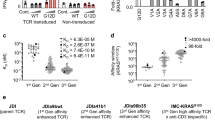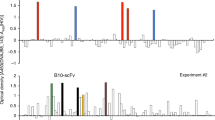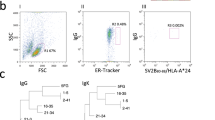Abstract
WT1126 (RMFPNAPYL) is a human leukocyte antigen-A2 (HLA-A2)-restricted peptide derived from Wilms tumor protein 1 (WT1), which is widely expressed in a broad spectrum of leukemias, lymphomas and solid tumors. A novel T-cell-receptor (TCR)-like single-chain variable fragment (scFv) antibody specific for the T-cell epitope consisting of the WT1/HLA-A2 complex was isolated from a human scFv phage library. This scFv was affinity-matured by mutagenesis combined with yeast display and structurally analyzed using a homology model. This monovalent scFv showed a 100-fold affinity improvement (dissociation constant (KD)=3 nm) and exquisite specificity towards its targeted epitope or HLA-A2+/WT1+ tumor cells. Bivalent scFv-huIgG1-Fc fusion protein demonstrated an even higher avidity (KD=2 pm) binding to the T-cell epitope and to tumor targets and was capable of mediating antibody-dependent cell-mediated cytotoxicity or tumor lysis by chimeric antigen receptor-expressing human T- or NK-92-MI-transfected cells. This antibody demonstrated specific and potent cytotoxicity in vivo towards WT1-positive leukemia xenograft that was HLA-A2 restricted. In summary, T-cell epitopes can provide novel targets for antibody-based therapeutics. By combining phage and yeast displays and scFv-Fc fusion platforms, a strategy for developing high-affinity TCR-like antibodies could be rapidly explored for potential clinical development.
This is a preview of subscription content, access via your institution
Access options
Subscribe to this journal
Receive 12 print issues and online access
$259.00 per year
only $21.58 per issue
Buy this article
- Purchase on Springer Link
- Instant access to full article PDF
Prices may be subject to local taxes which are calculated during checkout






Similar content being viewed by others
References
Doubrovina E, Carpenter T, Pankov D, Selvakumar A, Hasan A, O'Reilly RJ . Mapping of novel peptides of WT-1 and presenting HLA alleles that induce epitope-specific HLA-restricted T cells with cytotoxic activity against WT-1(+) leukemias. Blood 2012; 120: 1633–1646.
Santomasso BD, Roberts WK, Thomas A, Williams T, Blachere NE, Dudley ME et al. A T-cell receptor associated with naturally occurring human tumor immunity. Proc Natl Acad Sci USA 2007; 104: 19073–19078.
Keilholz U, Letsch A, Busse A, Asemissen AM, Bauer S, Blau IW et al. A clinical and immunologic phase 2 trial of Wilms tumor gene product 1 (WT1) peptide vaccination in patients with AML and MDS. Blood 2009; 113: 6541–6548.
Yee C . Adoptive T cell therapy: Addressing challenges in cancer immunotherapy. J Transl Med 2005; 3: 17.
Dahan R, Reiter Y . T-cell-receptor-like antibodies - generation, function and applications. Expert Rev Mol Med 2012; 14: e6.
Cohen CJ, Denkberg G, Lev A, Epel M, Reiter Y . Recombinant antibodies with MHC-restricted, peptide-specific, T-cell receptor-like specificity: new tools to study antigen presentation and TCR-peptide-MHC interactions. J Mol Recognit 2003; 16: 324–332.
Chames P, Hufton SE, Coulie PG, Uchanska-Ziegler B, Hoogenboom HR . Direct selection of a human antibody fragment directed against the tumor T-cell epitope HLA-A1-MAGE-A1 from a nonimmunized phage-Fab library. Proc Natl Acad Sci USA 2000; 97: 7969–7974.
Lev A, Noy R, Oved K, Novak H, Segal D, Walden P et al. Tumor-specific Ab-mediated targeting of MHC-peptide complexes induces regression of human tumor xenografts in vivo. Proc Natl Acad Sci USA 2004; 101: 9051–9056.
Stewart-Jones G, Wadle A, Hombach A, Shenderov E, Held G, Fischer E et al. Rational development of high-affinity T-cell receptor-like antibodies. Proc Natl Acad Sci USA 2009; 106: 5784–5788.
Holler PD, Chlewicki LK, Kranz DM . TCRs with high affinity for foreign pMHC show self-reactivity. Nat Immunol 2003; 4: 55–62.
Denkberg G, Reiter Y . Recombinant antibodies with T-cell receptor-like specificity: novel tools to study MHC class I presentation. Autoimmun Rev 2006; 5: 252–257.
Sastry KS, Too CT, Kaur K, Gehring AJ, Low L, Javiad A et al. Targeting hepatitis B virus-infected cells with a T-cell receptor-like antibody. J Virol 2011; 85: 1935–1942.
Sergeeva A, Alatrash G, He H, Ruisaard K, Lu S, Wygant J et al. An anti-PR1/HLA-A2 T-cell receptor-like antibody mediates complement-dependent cytotoxicity against acute myeloid leukemia progenitor cells. Blood 2011; 117: 4262–4272.
Verma B, Neethling FA, Caseltine S, Fabrizio G, Largo S, Duty JA et al. TCR mimic monoclonal antibody targets a specific peptide/HLA class I complex and significantly impedes tumor growth in vivo using breast cancer models. J Immunol 2010; 184: 2156–2165.
Willemsen RA, Debets R, Hart E, Hoogenboom HR, Bolhuis RL, Chames P . A phage display selected fab fragment with MHC class I-restricted specificity for MAGE-A1 allows for retargeting of primary human T lymphocytes. Gene Ther 2001; 8: 1601–1608.
Dao T, Yan S, Veomett N, Pankov D, Zhou L, Korontsvit T et al. Targeting the intracellular WT1 oncogene product with a therapeutic human antibody. Sci Transl Med 2013; 5: 176ra133.
Tassev DV, Cheng M, Cheung NK . Retargeting NK92 cells using an HLA-A2-restricted, EBNA3C-specific chimeric antigen receptor. Cancer Gene Ther 2012; 19: 84–100.
Oren R, Hod-Marco M, Haus-Cohen M, Thomas S, Blat D, Duvshani N et al. Functional comparison of engineered T cells carrying a native TCR versus TCR-like antibody-based chimeric antigen receptors indicates affinity/avidity thresholds. J Immunol 2014; 193: 5733–5743.
Renshaw J, Orr RM, Walton MI, Te Poele R, Williams RD, Wancewicz EV et al. Disruption of WT1 gene expression and exon 5 splicing following cytotoxic drug treatment: antisense down-regulation of exon 5 alters target gene expression and inhibits cell survival. Mol Cancer Ther 2004; 3: 1467–1484.
Yang L, Han Y, Suarez Saiz F, Minden MD . A tumor suppressor and oncogene: the WT1 story. Leukemia 2007; 21: 868–876.
Sugiyama H . WT1 (Wilms' tumor gene 1): biology and cancer immunotherapy. Jpn J Clin Oncol 2010; 40: 377–387.
O'Reilly RJ, Dao T, Koehne G, Scheinberg D, Doubrovina E . Adoptive transfer of unselected or leukemia-reactive T-cells in the treatment of relapse following allogeneic hematopoietic cell transplantation. Semin Immunol 2010; 22: 162–172.
Rezvani K, Brenchley JM, Price DA, Kilical Y, Gostick E, Sewell AK et al. T-cell responses directed against multiple HLA-A*0201-restricted epitopes derived from Wilms' tumor 1 protein in patients with leukemia and healthy donors: identification, quantification, and characterization. Clin Cancer Res 2005; 11: 8799–8807.
Kohrt HE, Muller A, Baker J, Goldstein MJ, Newell E, Dutt S et al. Donor immunization with WT1 peptide augments antileukemic activity after MHC-matched bone marrow transplantation. Blood 2011; 118: 5319–5329.
Borbulevych OY, Do P, Baker BM . Structures of native and affinity-enhanced WT1 epitopes bound to HLA-A*0201: implications for WT1-based cancer therapeutics. Mol Immunol 2010; 47: 2519–2524.
Mailander V, Scheibenbogen C, Thiel E, Letsch A, Blau IW, Keilholz U . Complete remission in a patient with recurrent acute myeloid leukemia induced by vaccination with WT1 peptide in the absence of hematological or renal toxicity. Leukemia 2004; 18: 165–166.
de Wildt RM, Mundy CR, Gorick BD, Tomlinson IM . Antibody arrays for high-throughput screening of antibody-antigen interactions. Nat Biotechnol 2000; 18: 989–994.
Zhao Q, Zhu Z, Dimitrov DS . Yeast display of engineered antibody domains. Methods Mol Biol 2012; 899: 73–84.
Zhao Q, Chan YW, Lee SS, Cheung WT . One-step expression and purification of single-chain variable antibody fragment using an improved hexahistidine tag phagemid vector. Protein Expr Purif 2009; 68: 190–195.
Chen W, Feng Y, Zhao Q, Zhu Z, Dimitrov DS . Human monoclonal antibodies targeting nonoverlapping epitopes on insulin-like growth factor II as a novel type of candidate cancer therapeutics. Mol Cancer Ther 2012; 11: 1400–1410.
Cheung NK, Guo H, Hu J, Tassev DV, Cheung IY . Humanizing murine IgG3 anti-GD2 antibody m3F8 substantially improves antibody-dependent cell-mediated cytotoxicity while retaining targeting in vivo. Oncoimmunology 2012; 1: 477–486.
Imai C, Mihara K, Andreansky M, Nicholson IC, Pui CH, Geiger TL et al. Chimeric receptors with 4-1BB signaling capacity provoke potent cytotoxicity against acute lymphoblastic leukemia. Leukemia 2004; 18: 676–684.
Wittrup KD, Thurber GM, Schmidt MM, Rhoden JJ . Practical theoretic guidance for the design of tumor-targeting agents. Methods Enzymol 2012; 503: 255–268.
Dimitrov DS, Marks JD . Therapeutic antibodies: current state and future trends—is a paradigm change coming soon? Methods Mol Biol 2009; 525: 1–27, xiii.
Zhao Q, Feng Y, Zhu Z, Dimitrov DS . Human monoclonal antibody fragments binding to insulin-like growth factors I and II with picomolar affinity. Mol Cancer Ther 2011; 10: 1677–1685.
Li Y, Li H, Yang F, Smith-Gill SJ, Mariuzza RA . X-ray snapshots of the maturation of an antibody response to a protein antigen. Nat Struct Biol 2003; 10: 482–488.
Mareeva T, Martinez-Hackert E, Sykulev Y . How a T cell receptor-like antibody recognizes major histocompatibility complex-bound peptide. J Biol Chem 2008; 283: 29053–29059.
Epel M, Carmi I, Soueid-Baumgarten S, Oh SK, Bera T, Pastan I et al. Targeting TARP, a novel breast and prostate tumor-associated antigen, with T cell receptor-like human recombinant antibodies. Eur J Immunol 2008; 38: 1706–1720.
Noy R, Eppel M, Haus-Cohen M, Klechevsky E, Mekler O, Michaeli Y et al. T-cell receptor-like antibodies: novel reagents for clinical cancer immunology and immunotherapy. Expert Rev Anticancer Ther 2005; 5: 523–536.
Gerber JM, Qin L, Kowalski J, Smith BD, Griffin CA, Vala MS et al. Characterization of chronic myeloid leukemia stem cells. Am J Hematol 2011; 86: 31–37.
Engberg J, Yenidunya AF, Clausen R, Jensen LB, Sorensen P, Kops P et al. Human recombinant Fab antibodies with T-cell receptor-like specificities generated from phage display libraries. Methods Mol Biol 2003; 207: 161–177.
Gilham DE, Debets R, Pule M, Hawkins RE, Abken H . CAR-T cells and solid tumors: tuning T cells to challenge an inveterate foe. Trends Mol Med 2012; 18: 377–384.
Ramos CA, Dotti G . Chimeric antigen receptor (CAR)-engineered lymphocytes for cancer therapy. Expert Opin Biol Ther 2011; 11: 855–873.
Mardiros A, Dos Santos C, McDonald T, Brown CE, Wang X, Budde LE et al. T cells expressing CD123-specific chimeric antigen receptors exhibit specific cytolytic effector functions and anti-tumor effects against human acute myeloid leukemia. Blood 2013; 122: 3138–3148.
Cheung NK, Dyer MA . Neuroblastoma: developmental biology, cancer genomics and immunotherapy. Nat Rev Cancer 2013; 13: 397–411.
Esser R, Muller T, Stefes D, Kloess S, Seidel D, Gillies SD et al. NK cells engineered to express a GD2 -specific antigen receptor display built-in ADCC-like activity against tumour cells of neuroectodermal origin. J Cell Mol Med 2012; 16: 569–581.
Kruschinski A, Moosmann A, Poschke I, Norell H, Chmielewski M, Seliger B et al. Engineering antigen-specific primary human NK cells against HER-2 positive carcinomas. Proc Natl Acad Sci USA 2008; 105: 17481–17486.
Cho D, Shook DR, Shimasaki N, Chang YH, Fujisaki H, Campana D . Cytotoxicity of activated natural killer cells against pediatric solid tumors. Clin Cancer Res 2010; 16: 3901–3909.
Shook DR, Campana D . Natural killer cell engineering for cellular therapy of cancer. Tissue Antigens 2011; 78: 409–415.
Cheever MA, Allison JP, Ferris AS, Finn OJ, Hastings BM, Hecht TT et al. The prioritization of cancer antigens: a national cancer institute pilot project for the acceleration of translational research. Clin Cancer Res 2009; 15: 5323–5337.
Acknowledgements
This study was supported in part by Katie Find a Cure Fund, Cycle for Survival and Robert Steel Foundation. Technical services provided by the MSKCC Small-Animal Imaging Core Facility were supported in part by NIH Cancer Center Support Grant No. 2 P30 CA008748-48. We thank Dr Mamoru Ito of Central Institute for Experimental Animals, Kawasaki, Japan for kindly providing the DKO mice for our studies. We are grateful to Dr Gloria Koo, Hospital for Special Surgery, New York, NY, USA for her expertise and advice in handling these DKO mice. We thank Dr Dario Campana and St Jude Children’s Research Hospital for sharing with us the vector for chimeric antigen receptor. We also thank Dr Jian Hu for technical assistance.
Author information
Authors and Affiliations
Corresponding author
Ethics declarations
Competing interests
QZ, MA, DVT, RJO and N-KVC were named as inventors in patents related to WT1 filed by Memorial Sloan Kettering Cancer Center for which a license has been obtained. The other authors declare no conflict of interest.
Additional information
Supplementary Information accompanies this paper on the Leukemia website
Rights and permissions
About this article
Cite this article
Zhao, Q., Ahmed, M., Tassev, D. et al. Affinity maturation of T-cell receptor-like antibodies for Wilms tumor 1 peptide greatly enhances therapeutic potential. Leukemia 29, 2238–2247 (2015). https://doi.org/10.1038/leu.2015.125
Received:
Revised:
Accepted:
Published:
Issue Date:
DOI: https://doi.org/10.1038/leu.2015.125
This article is cited by
-
TCR-like CARs and TCR-CARs targeting neoepitopes: an emerging potential
Cancer Gene Therapy (2021)
-
Adaptive T cell immunotherapy in cancer
Science China Life Sciences (2021)
-
TARP as antigen in cancer immunotherapy
Cancer Immunology, Immunotherapy (2021)
-
TCR-like antibodies in cancer immunotherapy
Journal of Hematology & Oncology (2019)
-
Identification of TCR Vβ11-2-Dβ1-Jβ1-1 T cell clone specific for WT1 peptides using high-throughput TCRβ gene sequencing
Biomarker Research (2019)



